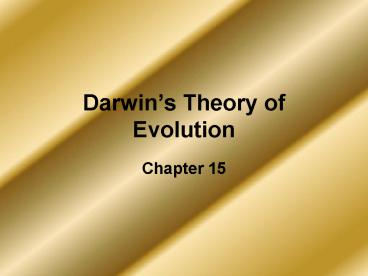Darwins Theory of Evolution - PowerPoint PPT Presentation
1 / 18
Title:
Darwins Theory of Evolution
Description:
The different sizes, shapes and habitats of organisms is ... Coypu. Capybara. Coypu and Capybara. Turtle. Alligator. Bird. Mammal. Ancient lobe-finned fish ... – PowerPoint PPT presentation
Number of Views:31
Avg rating:3.0/5.0
Title: Darwins Theory of Evolution
1
Darwins Theory of Evolution
- Chapter 15
2
Puzzle of Lifes Diversity
- The different sizes, shapes and habitats of
organisms is called biodiversity. - The evolution theory is a collection of
scientific facts, observations hypotheses - Evolution a change over time has alter organisms
in the past to the diversity of today. - Theory well-supported, testable explanation of
natural phenomena.
3
Voyage of the HMS Beagle
- Charles Darwin is the father of Evolution.
- Born in England on 2-12-1809
- Naturalists on the HMS Beagle in 1831
- Darwin collected numerous observations and
evidence to create his hypothesis. - Darwins hypothesis has been supported by huge
quantities of evidence and is a theory.
4
Darwins Voyage
5
Darwins Observations
- Darwin noticed patterns in the diversity of the
animals. Similar habitats had different
organisms in them. - Fossils collected often looked similar to
existing species others were different. - Galapagos Islands provided the most information
for diversity and climate. - Isolation on an island could lead to change over
time in a species.
6
Giant Tortoises of the Galápagos Islands
Pinta
Tower
Marchena
Pinta IslandIntermediate shell
James
Fernandina
Santa Cruz
Isabela
Santa Fe
Hood Island Saddle-backed shell
Floreana
Hood
Isabela Island Dome-shaped shell
7
Darwins Experience
- James Hutton stated the Earth changes slowly over
time by natural processes. - Charles Lyell wrote Principles of Geology which
stressed explaining the world in observable
processes. - Thomas Malthus described human population growth
over population. - All of these ideas went against the established
dogma.
8
Movement of Earths Crust
Sea level
Sea level
Sedimentary rocks form in horizontal layers.
When part of Earths crust is compressed, a bend
in a rock forms, tilting the rock layers.
As the surface erodes due to water, wind, waves,
or glaciers, the older rock surface is exposed.
New sediment is then deposited above the exposed
older rock surface.
9
Lamarcks Evolution
- Jean-Baptiste Lamarck first realized living
things change and adapt to their environment. - Lemarck said that organisms have an innate desire
to be complex and perfect. - Lemarck proposed use and disuse lead to acquired
traits which may be passed to offspring. - Lemarcks hypothesis has been proven incorrect.
10
Lamarcks Theory of Evolution
11
Darwins Evolution
- Darwin published his work in 1859 after Alfred
Wallace wrote similar papers. - Darwin stated that inherited variation and
artificial selection caused differences in a
species. - Struggle for Existence results in each member of
a species competing for resources.
12
Survival of the Fittest
- Fitness is the ability to survive and reproduce
in ones environment. - Adaptation is an inherited trait which increases
fitness. - Survival of the fittest means the best suited to
an environment survive to reproduce similar
offspring. - Natural Selection is survival of the fittest.
- Over time Natural selection may alter a species.
- Descent with Modification cause a species to
gradually change from its ancestor species.
13
Evidence of Evolution
- The fossil record, geographical distribution,
homologous structures, and embryology are all
evidences for evolution. - Fossils have shown intermediate species.
- Organisms living in different areas with similar
environmental pressures evolved similar anatomies
and behaviors - Homologous structures develop differently but
have the same embryonic tissues. Vestigial organs
exists but serve no purpose. - Embryos look similar during different stages of
deveolpment.
14
Embryology
dog
human
skink
zebrafish
chicken
15
Evidence of Evolution
Evidence of Evolution
includes
which is composed of
which indicates
which implies
which implies
16
Beaver
Beaver
Muskrat
NORTH AMERICA
Muskrat
Beaver and Muskrat
Coypu
Capybara
SOUTH AMERICA
Capybara
Coypu and Capybara
Coypu
17
Homologous Body Structures
Turtle
Alligator
Bird
Mammal
Ancient lobe-finned fish
18
Summary of Darwin
- Individual organisms differ and some of this
variation is heritable. - Organisms produce more offspring than can
survive, those that do not survive do not
reproduce. - Competition is created by producing more
offspring than can survive. - Organisms best suited for their environment
survive to pass on their traits. - Species alive today descended with modification
from species in the distant past. - Evolution is a theory and changes as new research
is discovered.































